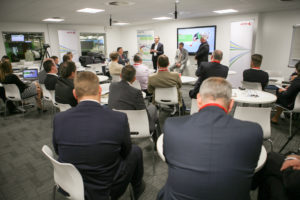Differing views on what makes a true white paper facility generally amount to little more than an academic discussion. But for Capita, it is a matter of substantial business consequence.
As the managing director of Document & Information Services for U.K. business process outsourcing leader Capita, Craig Hall had a mandate to bring some big volumes of its outsourced transactional print back in house. To accommodate the repatriated work, he needed to add a production plant. And he wanted it to be a high-efficiency white paper facility, one in which white paper is fed to an inkjet press and full-color complete mail-pieces come out ready to be mailed, eliminating letterheads, envelopes and their associated warehousing to save money and boost productivity.
[youtube]https://youtu.be/47UmbXvZ56w[/youtube]
What does Capita’s white paper facility have that the others don’t? That was revealed in a recent half-day open-house event at Capita, co-hosted with Xerox, called, “Seeing is Believing—How to Build a Plain Paper Factory from the Ground Up.” Forty people attended with key partners who jointly developed Capita’s solution. Hall headlined the presentation schedule, which also included consultant Neil Falconer and Xerox Senior Vice President Eric Bouet.
Xerox project-managed the solution design and implementation, working with all the partner companies to integrate their components and be operational shortly after equipment delivery.
A key differentiator is the degree to which the shop is “future-proofed.” Capita avoided software that tied the company too closely to one manufacturer—potentially inhibiting future changes—by acquiring “best-of-breed” systems and equipment.
Two Xerox Impika inkjet presses—the top-of-the-line Xerox Impika Evolution and the Xerox Impika Reference—were bought with Hall feeling strongly that Xerox’s vision for the future complemented his own. By building future products to fit the same field-upgradeable chassis, Xerox Impika potentially enables Capita to add speed, new inkjet heads and inks, and other enhancements.
“A lot of shops have white paper workflow on the front end,” Hall said. “But their productivity drops off on the back end.” Not so at Capita, where a CMC paper wrap fashions windowed envelopes from paper printed by the Xerox Impika inkjet presses. White-paper efficiency is maintained, and inkjet printing enables complete customization anywhere on the envelope, adding value with messaging that can pique the recipient’s interest to open—and pay—an invoice immediately, rather than throw it on the mail pile. Even the business reply envelope (BRE) inserted into the mail-piece is printed bespoke for each different customer enabling enhanced tracking of returned mail-pieces.
Another differentiator: Capita’s shop is automated not only for production, but for providing the very granular audit controls needed to achieve and demonstrate compliance with regulations and governance. Every job the shop produces is tracked down to the page level in real time and can be called up with just a few clicks in Capita’s customer interface that overlays Ironsides management system. That system can also provide immediate, proactive warnings at the first sign anything is going off track—to maintain peak efficiency.
“Is there good return on investment?” Hall was asked. “Yes,” he answered, “We’re starting to pitch out into the commercial market as well. In three years, Capita wants our operation here to be three times its size, and that is exactly where we’re heading.”
Capita continues to look for ways to bring value to its customers. In the near future, they hope to play a role in making it easier to interact with printed transactional documents using today’s multi-communications platforms. Hall demonstrated an augmented reality app under development that lets users perform such tasks as automatically submitting their gas and electric meter readings.
“We’re in an incredibly changing market,” Hall said. “You have to keep moving forward to constantly challenge yourself to stay relevant.”



